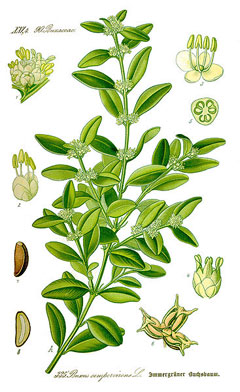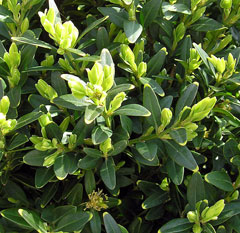 |
|
http://commons.wikimedia.org/wiki/File:Illustration_Buxus_sempervirens1_cleaned.jpg |
 |
| http://commons.wikimedia.org/wiki/User:Vdegroot |
Translate this page:
Summary
Bloom Color: Green.
Main Bloom Time: Early spring, Late spring, Mid spring. Form: Rounded.
Physical Characteristics

 Buxus sempervirens is an evergreen Shrub growing to 5 m (16ft) by 5 m (16ft) at a slow rate.
Buxus sempervirens is an evergreen Shrub growing to 5 m (16ft) by 5 m (16ft) at a slow rate.
See above for USDA hardiness. It is hardy to UK zone 5. It is in leaf all year, in flower from April to May, and the seeds ripen in September. The species is monoecious (individual flowers are either male or female, but both sexes can be found on the same plant) and is pollinated by Bees, flies.
It is noted for attracting wildlife.
Suitable for: light (sandy), medium (loamy) and heavy (clay) soils, prefers well-drained soil and can grow in heavy clay soil. Suitable pH: mildly acid, neutral and basic (mildly alkaline) soils and can grow in very alkaline soils.
It can grow in semi-shade (light woodland) or no shade. It prefers dry or moist soil.
UK Hardiness Map
US Hardiness Map
Synonyms
Plant Habitats
Woodland Garden Dappled Shade; Shady Edge; Hedge;
Edible Uses
Edible Parts:
Edible Uses: Condiment
The leaves have been used in France as a substitute for hops (Humulus lupulus) in making beer[7]. They cannot be very wholesome, and would probably prove to be injurious[2].
References More on Edible Uses
Medicinal Uses
Plants For A Future can not take any responsibility for any adverse effects from the use of plants. Always seek advice from a professional before using a plant medicinally.
Alterative Antiperiodic Antirheumatic Cathartic Cholagogue Diaphoretic Epilepsy Febrifuge
Homeopathy Leprosy Malaria Narcotic Odontalgic Oxytoxic Sedative
Tonic Vermifuge
Although it has been used medicinally in the past as a sedative and to treat syphilis, box is very rarely used in modern herbalism[268]. The leaves and the bark are alterative, antirheumatic, cathartic, cholagogue, diaphoretic, febrifuge, oxytocic and vermifuge[4, 7, 9, 21, 178]. The leaves have been used as a quinine substitute in the treatment of malaria[7]. The leaves are harvested in the spring, before the plant comes into flower, and they are dried for later use[238]. The bark can be harvested at any time of the year and is dried for use in decoctions[238]. Use this remedy with caution and preferably only under the supervision of a qualified practitioner. The plant has not been fully tested for its toxic side effects[7, 21]. The wood is diaphoretic, in full dose it is narcotic and sedative, in overdose it is convulsant and emetico-cathartic[4]. A tincture of the wood has been used as a bitter tonic and antiperiodic, it has also had a reputation for curing leprosy[4]. A volatile oil distilled from the wood has been prescribed in cases of epilepsy[4]. An essential oil obtained from the plant is used in dentistry[7]. A homeopathic remedy is made from the plant[7]. It is extensively used in the treatment of rheumatism[7].
References More on Medicinal Uses
The Bookshop: Edible Plant Books
Our Latest books on Perennial Plants For Food Forests and Permaculture Gardens in paperback or digital formats.

Edible Tropical Plants
Food Forest Plants for Hotter Conditions: 250+ Plants For Tropical Food Forests & Permaculture Gardens.
More

Edible Temperate Plants
Plants for Your Food Forest: 500 Plants for Temperate Food Forests & Permaculture Gardens.
More

More Books
PFAF have eight books available in paperback and digital formats. Browse the shop for more information.
Shop Now
Other Uses
Dye Hedge Hedge Wood
Box makes an excellent hedge from 45cm to 4.5 metres tall according to the variety grown[11, 29]. It is quite slow growing but very tolerant of cutting and is often used in topiary, where the hedge is trimmed into different forms for ornamental effect[182]. The leaves and sawdust, boiled in lye, have been used to dye hair an auburn colour[4]. Wood - hard, close grained, heavy. Although the wood is rather small, it is highly valued on account of its hardness - it is twice as hard as oak (Quercus species)[4, 268]. It is used for engraving, printing blocks, bowls, combs etc[4, 7, 11, 46, 100, 115, 178]. The root especially is much liked by turners and cabinet makers[7].
Special Uses
Attracts Wildlife Hedge Hedge Scented Plants
References More on Other Uses
Cultivation details
Landscape Uses:Container, Foundation, Screen, Woodland garden. Succeeds in almost any soil that is well-drained[11, 200], preferring light shade and chalky soils[9, 11, 28, 31]. Succeeds in dry shade[188]. Tolerates a pH range from 5.5 to 7.4[200]. A very hardy plant, tolerating temperatures down to at least -23°c, though it prefers milder winters[238]. A very polymorphic species, it is a very ornamental but slow growing plant[11] and there are many named varieties developed for their ornamental value[182]. This species is notably resistant to honey fungus[88, 200]. A good bee plant[108]. Plants are very tolerant of being trimmed, they can be cut right back to the base if required and will usually resprout freely[11, 29]. The foliage is pungently scented, especially when wet[245]. Special Features:
Attractive foliage, Not North American native, All or parts of this plant are poisonous, Inconspicuous flowers or blooms.
References Carbon Farming Information and Carbon Sequestration Information
Temperature Converter
Type a value in the Celsius field to convert the value to Fahrenheit:
Fahrenheit:
The PFAF Bookshop
Plants For A Future have a number of books available in paperback and digital form. Book titles include Edible Plants, Edible Perennials, Edible Trees,Edible Shrubs, Woodland Gardening, and Temperate Food Forest Plants. Our new book is Food Forest Plants For Hotter Conditions (Tropical and Sub-Tropical).
Shop Now
Plant Propagation
Seed - stratification is not necessary but can lead to more regular germination[113]. The seed is best sown in a cold frame as soon as it is ripe[138]. Sow stored seed as early in the year as possible in a cold frame. It usually germinates in 1 - 3 months at 15°c but stored seed can take longer[138]. When large enough to handle, prick the seedlings out into individual pots and grow them on in the greenhouse for at least their first winter, planting them out into their permanent positions in late spring or early summer, after the last expected frosts. Cuttings of short side shoots with a heel, September in a frame[200]. High percentage[78]. Rather slow to root[K]. Nodal cuttings in spring in a frame. Fairly easy[200].
Other Names
If available other names are mentioned here
Native Range
TEMPERATE ASIA: Iran (north), Turkey, Azerbaijan EUROPE: United Kingdom, Austria, Belgium, Switzerland, Germany, Former Yugoslavia, Albania, Greece, Italy (incl. Sardinia), Spain, France (incl. Corsica), Portugal (incl. Azores) AFRICA: Algeria, Libya, Morocco
Weed Potential
Right plant wrong place. We are currently updating this section.
Please note that a plant may be invasive in one area but may not in your area so it's worth checking.
Conservation Status
IUCN Red List of Threatened Plants Status :

Growth: S = slow M = medium F = fast. Soil: L = light (sandy) M = medium H = heavy (clay). pH: A = acid N = neutral B = basic (alkaline). Shade: F = full shade S = semi-shade N = no shade. Moisture: D = dry M = Moist We = wet Wa = water.
Now available:
Food Forest Plants for Mediterranean Conditions
350+ Perennial Plants For Mediterranean and Drier Food Forests and Permaculture Gardens.
[Paperback and eBook]
This is the third in Plants For A Future's series of plant guides for food forests tailored to
specific climate zones. Following volumes on temperate and tropical ecosystems, this book focuses
on species suited to Mediterranean conditions—regions with hot, dry summers and cool, wet winters,
often facing the added challenge of climate change.
Read More
Expert comment
Author
L.
Botanical References
1117200
Links / References
For a list of references used on this page please go here
Readers comment